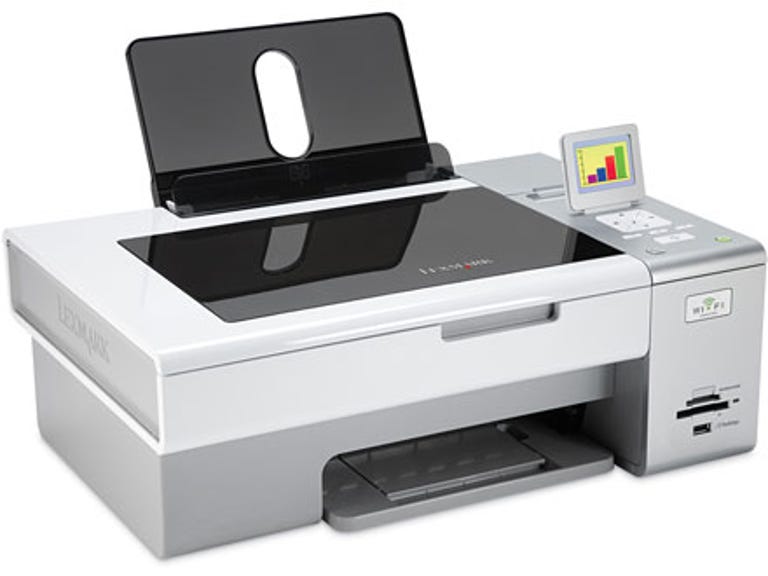 Why You Can Trust CNET
Why You Can Trust CNET Lexmark X4875 review: Lexmark X4875
It's a step back in the style stakes, but there's still plenty to like about Lexmark's latest small office wireless printer.
Design
Ever so slowly, Lexmark is evolving its printer design, but in the case of the Lexmark X4875, we can't help but think that it's taking a step backwards. For some time, it's been possible to identify a Lexmark printer, as they tended towards a rather iPod-style design, with lots of flowing white plastic edges. They were, in essence, trying to step away from looking quite so much like printers, which was a tough task to begin with.
The Good
The Bad
The Bottom Line
The X4875, on the other hand, takes that smooth white design and applies it against a blueprint that looks almost exactly like a printer. Perhaps it's the rather boxy overall design, or the contrast between the white, grey and silver sections of the body. Possibly it's a deliberate design idea, as the X4875 sits in the "Small & Medium Business" section of Lexmark's printer lines, although with the current razor-sharp pricing model for all inkjets, it's often confusing working out which market a particular inkjet is trying to hit.
Features
The X4875 sits in Lexmark's "Professional" range of inkjets, designed for small home offices and the like. The core printing engine in the X4875 is a four-colour inkjet, although like most inkjets you can pop in a six-colour photo cartridge if needed. Scanning is provided via a 48-bit A4 scanner built into the tray head. There's no faxing capability in the X4875; within the Lexmark world if you want faxing with this style body you'll need the AU$299 X6575 model instead.
One of the big hooks for the X4875 is the inclusion of wireless printing; this is managed via an 802.11g wireless antenna located at the back of the printer. We can't think of too many print jobs that a printer of this type would be called upon that would natively require the claimed speeds of 802.11n; G should be able to handle most data-intensive printing jobs.
One minor feature we did like that dropped out of the X4875's box was the inclusion of post-paid return envelopes for the print cartridges. Lexmark's a major sponsor of the Cartridges 4 Planet Ark initiative and it's a great step to see an active, consumer-led step like this.
Performance and Image Quality
For the most part, installing the X4875 was a simple affair, but we couldn't in all honesty call it a short process. When even the installation software for a product notes that it could take 30 minutes or more to complete, you know you've got to worry. Bear in mind, too, that this was just for setting up the printer on any given system; the unpacking, removing bits of tape and cartridge insertion time is all on top of that estimate.
We connected the X4875 wirelessly to a network comprising several Windows (XP and Vista) and Mac OS X (Leopard 10.5.3) machines. For the most part wireless printing was smooth, although one of our Macbooks intermittently had troubles seeing the printer. The same wasn't true of our test iMac, so we can't entirely lay the blame at the X4875's doorstop for that one. The X4875 also supports direct USB connection from the rear, and somewhat amusingly, while it ships with a standard USB cable, this is labelled as a "wireless setup" cable — as though you'd only use it for the initial set-up and then never again.
Coverage for plain text was quite good whether using normal or draft — Lexmark refers to it as "Quick Print" — modes. As always, vendor speeds need to be taken with a grain of salt; Lexmark claims "up to" 30 pages per minute (ppm) black and "up to" 27ppm colour for the X4875. Test printing with an average coverage, real world text document, we managed to get an initial page printing within 21 seconds on normal coverage, with a total of 4.2ppm coming out of the X4875. If you can live with the lighter tones of the draft coverage mode, those speeds ramp up nicely, with the first page taking 12 seconds, but the printer managing a solid 12 pages flying out in the initial minute. It's worth noting that the printer body does vibrate quite a bit when printing in draft, as it really tries to fling out as many pages as possible.
Moving on to colour images and photos, the X4875 didn't fare quite as well, although we were only testing with the default four-colour cartridge, and we'd hoped that the dedicated photo kit gave better results. Certainly, if your small office work is also going to encompass photography, we'd say the photo cartridge would be almost compulsory, given the generally poor photos the X4875 spat out.
The X4875 uses Lexmark's #43XL and #41 Colour Cartridges, with a claimed coverage of 500 and 205 pages respectively, and the #44XL and #43 Black Cartridges, which will give you 500 and 220 pages according to Lexmark's figures. As a rough guide, we found the #43 cartridge online for between AU$30-$35, which works out to a rough cost per page of AU$0.06-7.


